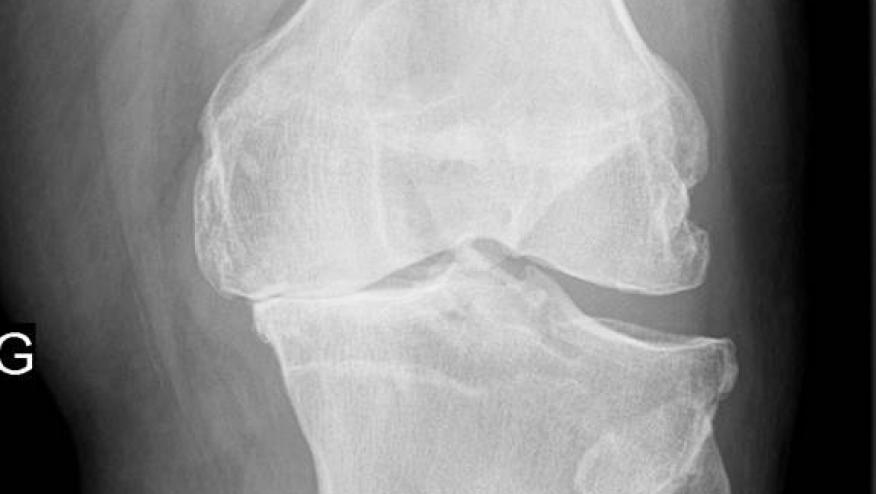Failed Osteoarthritis Pulse Ultrasound Study Save

A promising therapy aimed at halting and even reversing the pathology underlying osteoarthritis (OA) of the knee failed to show any benefit in a randomized trial.
Neither clinical nor radiographic outcomes differed between patients who received pulsed low-intensity ultrasound (PLIUS) for 48 weeks and a sham-treated control group, according to Allen D. Sawitzke, MD, of the University of Utah in Salt Lake City, and colleagues.
Clinically relevant symptomatic improvement was seen in 70.4% of the PLIUS group versus 67.3% of those receiving sham ultrasound (P=0.84), the researchers reported in JAMA Network Open.
Moreover, cartilage degradation appeared to progress further in the PLIUS group than in controls (mean -73.8 vs -42.2 μm), although the difference did not reach statistical significance.
The finding of continued cartilage loss was especially disappointing and surprising, insofar as PLIUS is an established therapy for non-union bone fractures and because some animal and lab studies had found it could promote cartilage growth. A 90-patient clinical trial reported in 2018, also with sham control, confirmed a symptomatic benefit but didn't assess radiographic outcomes.
Sawitzke and colleagues commenced their trial in 2014, eventually enrolling 132 knee OA patients in the Veterans Affairs health system randomized 1:1 to active or sham PLIUS. Participants averaged about 64 years old, about 90% men (as typical in VA-based studies), and roughly 80% white. Most patients were overweight or obese (mean BMI 32). Half the sample had OA severity graded as 3 on the Kellgren-Lawrence scale; 39% were at grade 2 and 11% were grade 1.
Patients treated themselves with a portable Bioventus device set to deliver an average of 30 mW/cm2 at a frequency 1.5 MHz, in 200-msec pulses at 1 kHz (active treatment) or to do nothing but appear to turn on (sham). It was to be applied once daily in 20-minute sessions. The device recorded each session so that the investigators could confirm reasonable compliance; ultimately they determined that it was used properly by more than 90% of participants.
Clinical outcomes were based on the Outcome Measures in Rheumatology Clinical Trials/Osteoarthritis Research Society International (OMERACT-OARSI) system, with a positive response defined as either more than 50% improvement in pain and function and at least 20% absolute improvement, or at least 20% improvement in two or more of pain, function, and patient global assessment. The primary radiographic outcome was MRI-measured central medial femoral condyle cartilage thickness; the means at baseline were 1,321 and 1,334 μm for the active and sham PLIUS groups, respectively.
On neither of these outcomes did active PLIUS outperform the sham therapy, nor was there a difference in any of the OMERACT-OARSI subscales. Biomarkers of cartilage degradation and formation (including serum collagen II cleavage, nitrated collagen II cleavage, cartilage oligomeric matrix protein, and C-terminal telopeptide of collagen II) also showed no significant differences between groups at week 48.
Similarly, secondary radiographic assessments, such as joint space width, identified no effect from active treatment.
Ultimately, it appeared that the placebo effect swamped any possible benefit from PLIUS. Sawitzke and colleagues noted that symptomatic improvements "occurred quickly in both the PLIUS and sham groups" -- mostly in the first 8 weeks, before substantial cartilage modifications would be expected. Placebo effects are the Achilles heel of all trials in OA, the researchers acknowledged, and will be difficult to overcome.
On the other hand, the group pointed out, PLIUS parameters in the current study were those used in fracture healing; it could be that, for cartilage repair, a different ultrasound regime could be more effective.
"We believe that this topic merits further study, given the documented anabolic effects of PLIUS for cartilage matrix in vitro and in preclinical animal studies and the current lack of any disease-modifying therapeutics for OA," Sawitzke and colleagues concluded.









If you are a health practitioner, you may Login/Register to comment.
Due to the nature of these comment forums, only health practitioners are allowed to comment at this time.